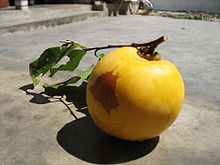Diospyros
Diospyros is a genus of about 450–500 species of deciduous and evergreen trees, shrubs and small bushes. The majority are native to the tropics, with only a few species extending into temperate regions. Depending on their nature, individual species commonly are known as ebony or persimmon trees. Some are valued for their hard, heavy, dark timber, and some for their fruit. Some are useful as ornamentals and many are of local ecological importance.
Taxonomy and etymology
The generic name Diospyros comes from the ancient Greek words "Dios" (διός) and "pyros" (πυρος). In context this means more or less "divine fruit" or "divine food", though its literal meaning is more like "Wheat of Zeus".[2][3] The interpretation of Diospyros is however sufficiently confusing to have given rise to some curious and inappropriate interpretations such as "God's pear" and Jove's fire". The name Diospyros was originally applied to the Caucasian Persimmon (D. lotus).
The genus is a large one and the number of species has been estimated variously, depending on the date of the source. The Royal Botanic Gardens, Kew list has over 1000 entries, including synonyms and items of low confidence. Over 700 species are marked as being assigned with high confidence.[4]
Ecology
Diospyros species are important and conspicuous trees in many of their native ecosystems, such as lowland dry forests of the former Maui Nui in Hawaii,[5]Caspian Hyrcanian mixed forests, Kathiarbar-Gir dry deciduous forests, Louisiade Archipelago rain forests, Madagascar lowland forests, Narmada Valley dry deciduous forests, New Guinea mangroves or South Western Ghats montane rain forests. The green fruits are rich in tannins and thus avoided by most herbivores; when ripe they are eagerly eaten by many animals however, such as the rare Aders' Duiker (Cephalophus adersi).
- Gymnoscelis rufifasciata (Double-striped Pug) – recorded on persimmons
- Neopithecops zalmora (Quaker)
- Charaxes khasianus (Kihansi Charaxes) – recorded on D. natalensis
- Dophla evelina (Redspot Duke) – recorded on D. candolleana
- Actias luna (Luna Moth) – recorded on persimmons
- Callosamia promethea (Promethea Silkmoth) – recorded on persimmons
- Citheronia regalis (Regal Moth) – recorded on American Persimmon (D. virginiana)
- "Cnephasia" jactatana (Black-lyre Leafroller Moth)
An economically significant plant pathogen infecting many Diospyros species – D. hispida, Kaki Persimmon (D. kaki), Date-plum (D. lotus), Texas Persimmon (D. texana), Coromandel Ebony (D. melanoxylon) and probably others – is the sac fungus Pseudocercospora kaki, which causes a leaf spot disease.
Use by humans
The genus includes several plants of commercial importance, either for their edible fruit (persimmons) or for their timber (ebony). The latter are divided into two groups in trade: the pure black ebony (notably from D. ebenum, but also several other species), and the striped ebony or Calamander wood (from D. celebica, D. mun and others). Most species in the genus produce little to none of this black ebony-type wood; their hard timber (e.g. of American Persimmon, D. virginiana) may still be used on a more limited basis.
Leaves of the Coromandel Ebony (D. melanoxylon) are used to roll South Asian beedi cigarettes. Several species are used in herbalism, and D. leucomelas yields the versatile medical compound betulinic acid. Though bees do not play a key role as pollinators, in plantations Diospyros may be of some use as honey plant. D. mollis, locally known as mặc nưa, is used in Vietnam to dye the famous black lãnh Mỹ A silk of Tân Châu district.
These trees are well-known in their native range, and consequently much used as floral emblems. In Indonesia, D. celebica (Makassar Ebony, known locally aseboni) is the provincial tree of Central Sulawesi, while ajan kelicung (D. macrophylla) is that of West Nusa Tenggara. The emblem of the Japanese island of Ishigakiis the Yaeyama kokutan (D. ferrea). In Thailand, the Gold Apple (D. decandra) is the provincial tree of Chanthaburi and Nakhon Pathom Provinces, while Black-and-white Ebony (D. malabarica) is that of Ang Thong Province. The name of the Thai district Amphoe Tha Tako literally means "District of the Diospyros pier" after a famous local gathering spot.
Species
- Diospyros acocksii (De Winter) De Winter
- Diospyros acris
- Diospyros affinis Thwaites
- Diospyros apeibacarpos Raddi
- Diospyros armata
- Diospyros atrata Thwaites
- Diospyros attenuata Thwaites
- Diospyros australis – Yellow Persimmon, Black Plum, "grey plum"
- Diospyros austroafricana De Winter
- Diospyros barberi
- Diospyros batocana Hiern
- Diospyros blancoi – Mabolo, Velvet-apple
- Diospyros brandisiana Kz.
- Diospyros canaliculata (= D. cauliflora, D. xanthochlamys)
- Diospyros candolleana Wight.
- Diospyros caribaea (A.DC.) Standl.
- Diospyros castanea (Craib) Fletcher
- Diospyros cathayensis Steward (= D. sinensis)
- Diospyros cauliflora Blume
- Diospyros celebica – Makassar Ebony
- Diospyros chaetocarpa Kosterm.
- Diospyros chamaethamnus – Sand Apple
- Diospyros chloroxylon
- Diospyros clavigera C.B.Clarke
- Diospyros confertifolia
- Diospyros compacta (R.Br.) Kosterm.
- Diospyros consolataei
- Diospyros conzattii Standl.
- Diospyros crumenata Thwaites
- Diospyros crassiflora Nesbitt – Gaboon Ebony
- Diospyros crassinervis (Krug & Urb.) Standl.
- Diospyros decandra Lour. – Gold Apple
- Diospyros dichrophylla (Gand.) De Winter
- Diospyros digyna – Black Sapote, Chocolate Pudding Fruit, "black persimmon"
- Diospyros diversifolia
- Diospyros ebenum – Ceylon Ebony, India Ebony, "ebony"
- Diospyros elliptica (J.R.Forst. & G.Forst.) P.S.Green
- Diospyros eriantha Champ. ex Benth.
- Diospyros fasciculosa
- Diospyros ferrea (Willd. ) Bakh.f.
- Diospyros fischeri
- Diospyros geminata
- Diospyros glabra (L.) De Winter
- Diospyros glandulosa Lace
- Diospyros glaucifolia F.P.Metcalf
- Diospyros gracilipes (Madagaskar)
- Diospyros grisebachii (Hiern) Standl.
- Diospyros guianensis (Aubl.) Gürke
- Diospyros halesioides Griseb.
- Diospyros hillebrandii
- Diospyros hispida DC.
- Diospyros humilis – Queensland Ebony
- Diospyros ierensis Britton
- Diospyros inconstans Jacq. (= D. psidioides)
- Diospyros inhacaensis F.White
- Diospyros insignis Thwaites
- Diospyros insularis Bakh.f – Papua Ebony
- Diospyros japonica Siebold & Zucc.
- Diospyros juruensis A.C.Sm.
- Diospyros kaki – Japanese Persimmon, Kaki Persimmon, Asian Persimmon
- Diospyros kirkii Hiern
- Diospyros kurzii – Andaman Marblewood
- Diospyros lanceifolia
- Diospyros leucomelas
- Diospyros littorea (R.Br.) Kosterm.
- Diospyros lokohensis
- Diospyros longibracteata Lecomte
- Diospyros lotus – Date-plum, Caucasian Persimmon
- Diospyros lycioides Desf. – Bushveld Bluebush
- Diospyros lycioides ssp. guerkei (Kuntze) De Winter
- Diospyros lycioides ssp. lycioides
- Diospyros lycioides ssp. nitens (Harv. ex Hiern) De Winter
- Diospyros lycioides ssp. sericea (Bernh.) De Winter
- Diospyros mabacea – Red-fruited Ebony
- Diospyros macrocalyx (= D. loureiroana)
- Diospyros macrophylla Blume
- Diospyros major (G.Forst.) Bakh.f.
- Diospyros major var. ebenus f. australiensis
- Diospyros malabarica (Desr.) Kostel. – Black-and-white Ebony, Pale Moon Ebony, Gaub Tree (= Diospyros embryopteris, D. peregrina[verification needed])
- Diospyros maritima Blume
- Diospyros marmorata R.N.Park. – Marblewood Ebony, "marblewood"
- Diospyros melanida
- Diospyros melanoxylon – Coromandel Ebony, East Indian Ebony
- Diospyros mespiliformis – Jackalberry, "African Ebony"
- Diospyros mindanaensis Merr. (= D. rosenbluthii)
- Diospyros mollis Griff.
- Diospyros montana Roxb. (= D. cordifolia, D. montana var. cordifolia)
- Diospyros moonii Thwaites
- Diospyros morrisiana Hance
- Diospyros multiflora
- Diospyros mun – Mun Ebony
- Diospyros natalensis (Harv.) Brenan
- Diospyros natalensis ssp. natalensis
- Diospyros natalensis ssp. nummularia (Brenan) F.White
- Diospyros nitida Merr.
- Diospyros oblongifolia (Thwaites) Kosterm.
- Diospyros oldhamii Maxim. (= D. taitoensis)
- Diospyros oleifera Cheng
- Diospyros oocarpa Thwaites
- Diospyros oppositifolia Thwaites
- Diospyros ovalifolia Wight
- Diospyros pallens (Thunb.) F.White
- Diospyros papuana Valeton ex Bakh.f.
- Diospyros pavonii
- Diospyros pentamera – Myrtle Ebony, Grey Persimmon, Black Myrtle, Grey Plum
- Diospyros philippinensis A.DC.
- Diospyros phlebodes (A.C.Sm.) A.C.Sm.
- Diospyros pilosanthera Blanco
- Diospyros piscatoria Gürke
- Diospyros poeppigiana
- Diospyros pyrrhocarpa Miq.
- Diospyros quaesita Thwaites
- Diospyros rhombifolia
- Diospyros ridleyi Bakh.f. (= D. crumenata auct. non Thwaites, D. pyrrhocarpa auct. non Miq., D. pyrrhocarpa var. andamanica, D. pyrrhocarpoides)
- Diospyros rosei Standl.
- Diospyros rotundifolia Hiern
- Diospyros rubra Lecomte
- Diospyros rumphii Bakh.f. (= D. macassar, D. utilis Koord & Val. (non Hemsl.))
- Diospyros samoensis A.Gray
- Diospyros sandwicensis
- Diospyros sapota Roxb.
- Diospyros sericea DC.
- Diospyros seychellarum Seychelles
- Diospyros siamang (= D. elliptifolia)
- Diospyros simii (Kuntze) De Winter
- Diospyros sintenisii (Krug & Urb.) Standl.
- Diospyros sonorae Standl.
- Diospyros subrotata
- Diospyros subtruncata Hochr.
- Diospyros sundaica Bakh.f. (= D. pseudoebenum)
- Diospyros sylvatica Roxb.
- Diospyros tessellaria Poir. – Mauritius Ebony
- Diospyros texana – Texas Persimmon, Mexican Persimmon, "black persimmon"
- Diospyros trichophylla (= D. pruriens)
- Diospyros tutcheri Dunn
- Diospyros venosa Wall. ex DC. (= D. hermaphroditica)
- Diospyros villosa (L.) De Winter
- Diospyros virginiana – American Persimmon, Eastern Persimmon, Common Persimmon, Possumwood
- Diospyros vitiensis
- Diospyros vitiensis var. longisepala (Gillespie) A.C.Sm. (= D. globosa)
- Diospyros whyteana (Hiern) F.White
- Diospyros tomentosa
- Diospyros sp. 'Bamaga'
- Diospyros sp. 'Mt Lewis'
- Diospyros sp. 'Mt Spurgeon'
ebony,Diospyros,Betulinic acid can be isolated fromDiospyros leucomelas,Ebony jivari of a sitar,Gold Apple (D. decandra) fruit,Diospyros dichrophylla,D. ferrea, known as Yaeyama kokutan inJapan










